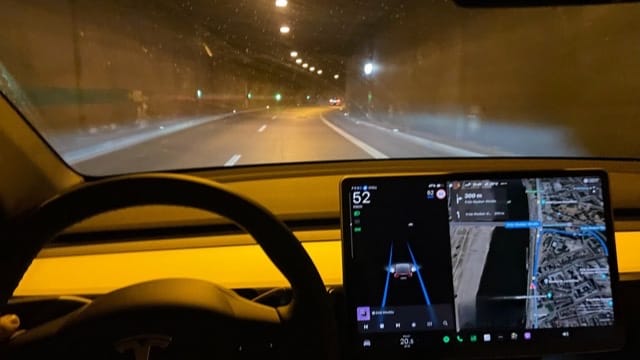Why my Tesla helps me navigate better than Google Maps ever will
Hint: Deep integration!

I’m driving to a neighbouring city to pick up a secondhand bicycle for my daughter’s upcoming birthday (she’s getting a bicycle).
There’s a tunnel and I enter it since that’s what my navigation on the Tesla screen tells me to do. I immediately feel something is weird.
Traditionally, before I drove a Tesla, entering a tunnel meant losing GPS signal on my iPhone. Every driver knows how much life is wasted driving around after a wrong exit, and I’m one who is particularly prone to exiting wrong. You can ask my wife.
Not this time. I drive at 40km/h in the tunnel and notice that the Tesla navigation pinpoints my location on the map as accurately as it did before I entered the tunnel.
Huh.
I step on the pedal and go to 50km/h. The map shifts noticeably faster under the triangle representing our location.
Interesting…
This was when my programmer brain turned on. How does Tesla do it?
Here’s my deduction, without checking sources: because the navigation system is integrated into the Tesla, the car is privy to a simple but vital stream of data that an iPhone simply doesn’t have.
The car always knows how fast it’s travelling.
Under the open sky, our phones and Google Maps can pinpoint our location relatively well because it has direct lines of communication to orbiting satellites.
Inside a tunnel, that line of communication is cut and Google Maps becomes John Travolta in Pulp Fiction, i.e. lost and confused.

But here’s the beautiful part: While your phone has just lost its understanding of its position and is blind, your car knows exactly when you entered a tunnel (when it lost signal, just like your phone). Plus, it knows how quickly you’re travelling (speedometer).
Computing how much you’ve travelled since entering a tunnel — and updating your location with pinpoint accuracy on a map — then becomes a matter of relatively simple arithmetic.
Here, let’s do a hypothetical scenario:
- Car reaches point X (start of tunnel)
- Knows it entered tunnel because it lost GPS signals
- Car starts recording speed every second
- S1: 40kmh
- S2: 39kmh
- S3: 42kmh
- … etc.
- Car does simple math operation to figure out distance travelled
- S1 = 1 second since entering tunnel = 40km / (60 * 60) = +11m
- S2 = 2 seconds since entering tunnel = +10.8m
- S3 = 3 seconds since entering tunnel = +11.6m
- … etc.
- Car does second step of simple math to add distance to compute new location
- P0 = location X
- P1 = P0 + 11m
- P2 = P1 + 10.8m
- P3 = P2 + 11.6m
- … etc.
Et voila!
But wait… what about forks in the underground roads? How would the car know which route you’ve actually taken?
Two immediate options come to mind (there are probably more, but these are the most straightforward and I have reason to believe Tesla engineers value simplicity):
- Simply assume that the driver is going to be a good robot and drive along the path that the navigation system is telling it to drive along, or,
- Use a 2nd stream of data that only the car (not the phone) has: the steering wheel angle.
Well… guess what? I’m guessing there isn’t much guessing needed at all.
Tesla has ridiculous amounts of data that’s being sent from its fleet of millions of vehicles every single second, so its data engineers can quite easily test hypotheses with data. Hypotheses like:
- Tesla drivers are good fleshy robots and drive along the route they’re told 90% of the time.
I think testing a hypothesis like that would be enough to inform which design to take. I’d choose #1 — just assume navigation path will be taken — if the hypothesis is right. For the rest of the 10% of the time, the position of the car on the map can be re-computed once GPS signals are re-established upon exiting the tunnel.
I’d choose #2 — use steering angle to determine which path is driven onto — otherwise.
It’s 10pm. I arrive at home with my daughter’s birthday present and I stow it in the cellar.
I look back at that ordinary drive and can’t help but marvel at how much more capable cars have become.
To me there’s no doubt that Tesla started this new wave of features in the automotive industry. Its innovations is why I bought one.
It also appears to still be leading the pack, because this is just one of the smaller, less talked about features. There’s a lot of marveling left for the things that are enabled by real-time vision-based AI like adaptive headlights, active collision avoidance, and self-driving.